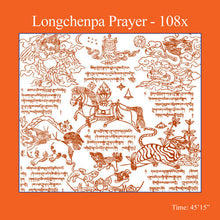Mantra Practice Volume 4 - Prayer to Longchenpa
*The Six Ornaments: Nagarjuna, Aryadeva, Asanga, Vasubandhu, Dignaga, and Dharmakirti
**The Two Most Excellent Ones: Gunaprabha and Shakyaprabha
The word mala means "garland" or rosary in Sanskrit. A mala consists of 108 or 27 beads. Buddha recommended the mantra practice as a path to enlightenment for ordinary people. Counting mantra with a mala engages the hand (body), the voice (speech) and the mind by visualizing the deity. Hold the mala gently and with respect. Start counting with the first bead after the guru bead. Count a bead for each completed recitation. When you complete either 108 or 4x27 recitations, do not pass over the guru bead. Instead, flip the mala around 180 degrees, and keep going the same direction. In closing you may like to dedicate merit to a specific person or group of people and all sentient beings.


